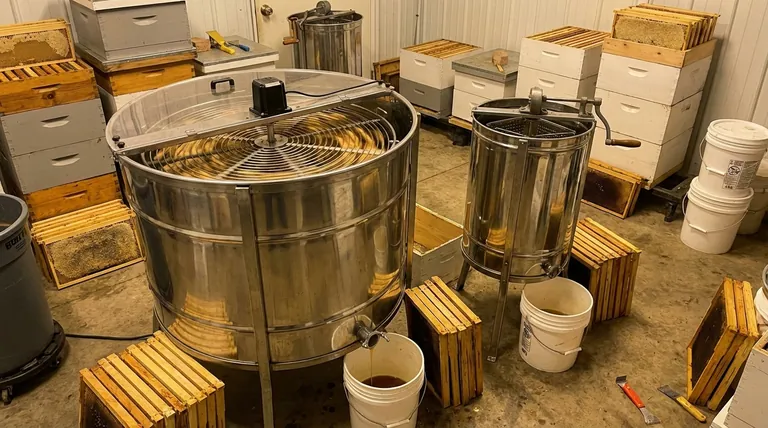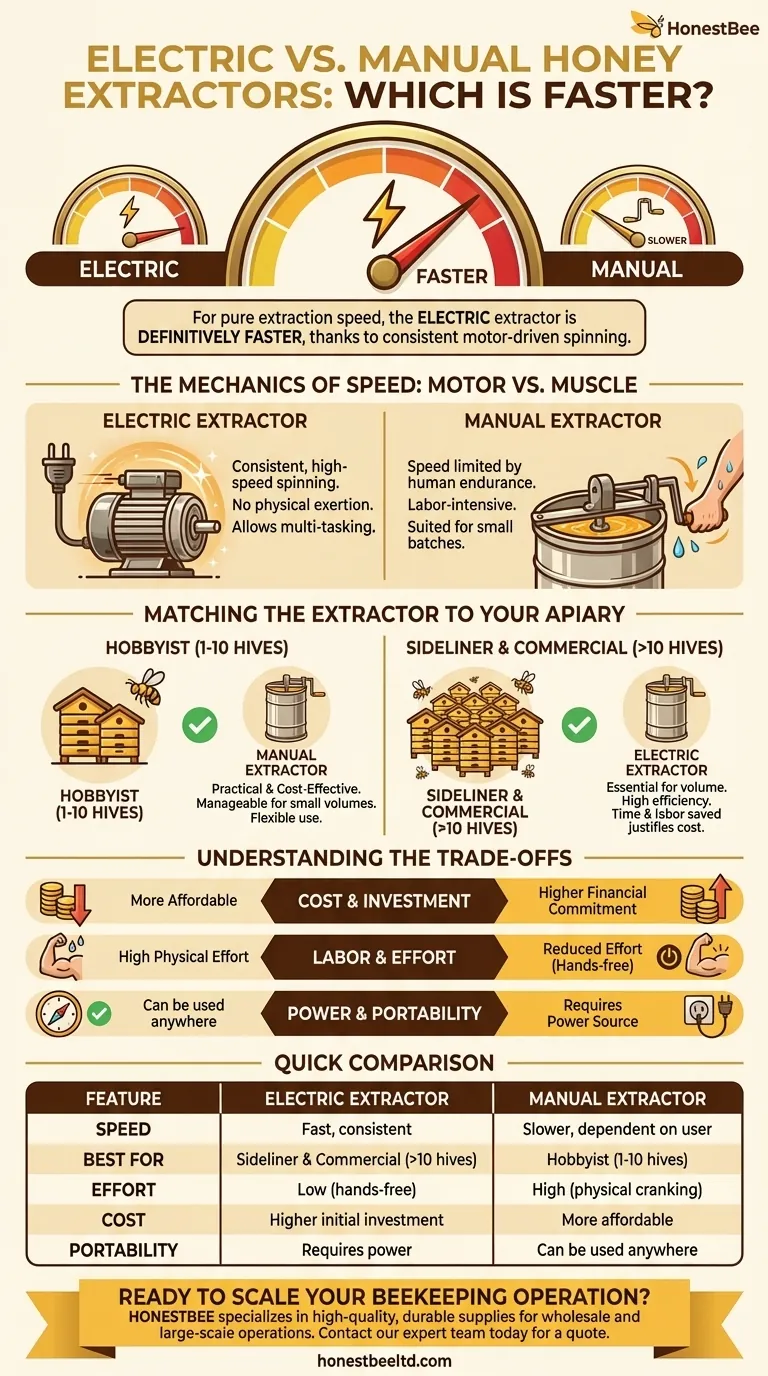For pure extraction speed, the answer is definitive. An electric honey extractor is significantly faster than a manual one. The use of a motor allows for consistent, high-speed spinning that requires no physical exertion from the operator, dramatically reducing the time it takes to process frames.
The choice between an electric and manual extractor isn't just about speed; it's about aligning your equipment with the scale of your beekeeping operation. The time saved by an electric model must be weighed against its higher cost and power requirements.

The Mechanics of Speed: Motor vs. Muscle
The fundamental difference in speed comes down to the power source. One relies on consistent electrical power, while the other depends on human endurance.
The Power of Electric Extractors
An electric extractor uses a motor to spin the basket containing the honey frames. This provides a consistent and high rotational speed that can be maintained for long periods without fatigue.
This automation is what makes it the superior choice for efficiency. It allows a beekeeper to uncap the next batch of frames while the current ones are spinning, creating a highly productive workflow.
The Control of Manual Extractors
A manual extractor is powered by a hand crank. The speed is limited by how fast and for how long you can physically turn the crank.
While much slower, this method is straightforward and does not require a power source. The process is more labor-intensive and best suited for small batches where time is not the primary constraint.
Matching the Extractor to Your Apiary
The right choice depends entirely on the size of your operation. What is a valuable investment for one beekeeper is an unnecessary expense for another.
For the Hobbyist (1-10 Hives)
For a beekeeper with just a few hives, a manual extractor is often the most practical and cost-effective solution. The smaller volume of honey makes the slower, more physical process entirely manageable.
The lower initial cost is a significant advantage, and the lack of reliance on electricity provides flexibility.
For the Sideliner or Commercial Beekeeper (>10 Hives)
Once you manage more than ten hives, an electric extractor transitions from a luxury to a near necessity. The sheer volume of frames to be processed makes the speed and efficiency of a motorized unit invaluable.
The time and labor saved directly translate into higher productivity, justifying the larger initial investment for any serious or large-scale operation.
Understanding the Trade-offs
Speed is just one factor in a larger equation. A clear-eyed view of the associated costs and benefits is essential.
Cost and Initial Investment
Manual extractors are significantly more affordable, making them the ideal entry point for new beekeepers. Electric models represent a much larger financial commitment.
Labor and Physical Effort
The primary benefit of an electric model, after speed, is the drastic reduction in physical effort. Manual extraction can be a strenuous workout, while electric models do the hard work for you.
Power and Portability
A manual extractor can be used anywhere, from a remote barn to an off-grid apiary. An electric extractor requires a reliable power source, which can limit where you can set up your extraction operation.
Making the Right Choice for Your Goal
Your decision should be based on a realistic assessment of your needs, budget, and the number of hives you manage.
- If your primary focus is a small-scale, cost-conscious hobby: A manual extractor is the practical and affordable choice for processing a few hives.
- If your primary focus is efficiency and large-volume production: An electric extractor is a necessary investment to save critical time and labor.
Ultimately, the best extractor is the one that fits the scale of your ambition and the size of your apiary.
Summary Table:
| Feature | Electric Extractor | Manual Extractor |
|---|---|---|
| Speed | Fast, consistent motor-driven | Slower, dependent on user stamina |
| Best For | Sideliner & Commercial (>10 hives) | Hobbyist (1-10 hives) |
| Effort | Low (hands-free operation) | High (physical cranking) |
| Cost | Higher initial investment | More affordable |
| Portability | Requires power source | Can be used anywhere |
Ready to Scale Your Beekeeping Operation?
Whether you're a commercial apiary managing hundreds of hives or a distributor supplying the industry, the right equipment is key to your productivity and profitability. HONESTBEE specializes in high-quality, durable beekeeping supplies and equipment designed for wholesale and large-scale operations.
Let us help you choose the perfect extractor to maximize your efficiency. Contact our expert team today to discuss your needs and get a competitive quote on equipment that will power your success.
Visual Guide

Related Products
- HONESTBEE 72 Frame Industrial Electric Honey Extractor for Beekeeping
- Commercial Electric 12 Frame Honey Extractor Spinner Motorized Honey Extractor
- Electric 8 Frame Honey Spinner Extractor Equipment for Beekeeping
- HONESTBEE 3-Frame Manual Acrylic Honey Extractor
- 2 Frame Stainless Steel Manual Honey Spinner Extractor for Beekeeping
People Also Ask
- Why do beekeepers have to lift a lot of weight at the end of a growing season? The Reward of a Heavy Harvest
- What are the advantages of automatic honey extractors? Scale Your Apiary with Unmatched Efficiency
- How do automatic honey extractors function? Achieve High-Efficiency Honey Harvesting
- What should a beekeeper do after extracting honey from supers? A Guide to Harvest Management
- Can a manual extractor be upgraded to an electric one? Save Labor & Boost Efficiency



















